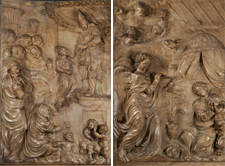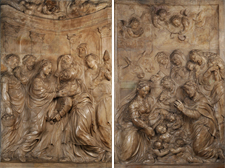Reliefs of the Life of the Virgin (Hall 22)


The four reliefs on view here come from the Main Altarpiece in the Cistercian monastery ofLa Espina in Valladolid. They were carved by artist Manuel Álvarez between 1570 and 1577. This exceptional set of pieces can be considered among the artist's master works from the Spanish Renaissance.
These scenes are representations of the life of the Virgin Mary. In chronological order, they include the Presentation of Mary in the Temple, the Annunciation, the Visitation and the Adoration of the Shepherds. The passages shown here have been taken from the Gospel of Luke, the evangelist who most thoroughly described the life of Mary.
These reliefs, which are sculpted in alabaster, show a variety of gradations that move from images that are highly undercut to others that are nearly flat. Together with their architectural backdrops, they create a sensation of space. The careful treatment of vestments, bearded faces and curly hair must be highlighted. The entire set has an Italianate air, and is clearly influenced by Florentine-Roman Mannerism.
The altarpiece (whose original dimensions and shape are unknown) was taken apart shortly after the withdrawal of the French, most probably due to damages suffered during the Peninsular War (1808-1814). Its various parts were dispersed at that time. Some of these have been preserved in other churches that are near the monastery. These four reliefs came up for sale and were discovered by Marès in the Paris antique market. With the help of Barcelona City Hall, he was able to acquire them in 1958. In doing so, the museum obviously contributed to the recovery of several pieces of Spanish heritage.


